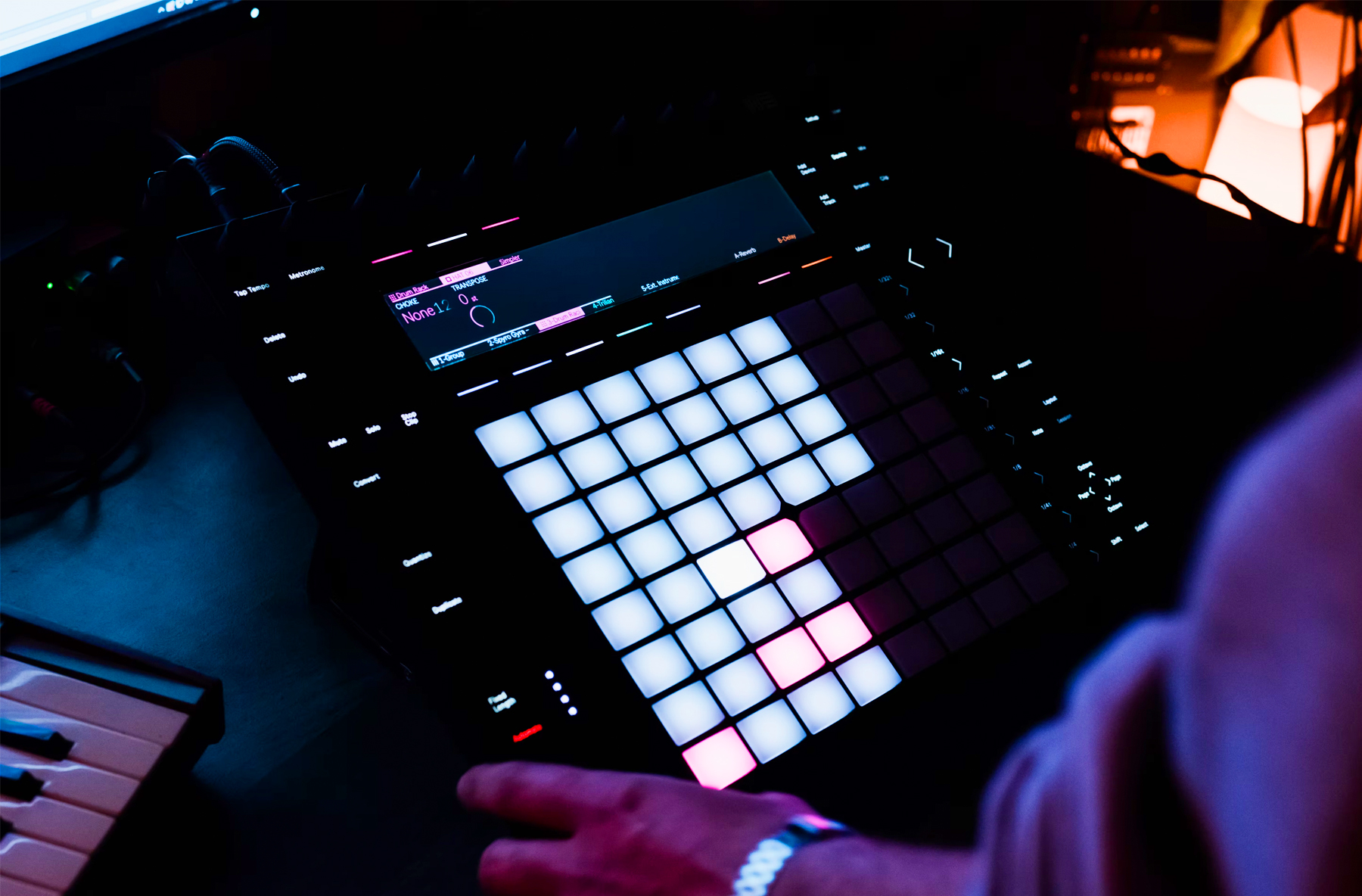Ableton Push changed the way a lot of us make music. It’s a sequencer, performance hub, keyboard and drum machine all in one. Having an “in key” mode to play chords, melodies and basslines takes the pressure off of possibly playing a wrong note but what happens when you’re writing with someone who plays piano or guitar? Or an artist who wants to use non-diatonic notes in a vocal line?
Ableton Certified Trainer and PBLA instructor Jamie Blake has compiled a list of 6 reasons Ableton Push is better in chromatic mode.

I grew up playing the drums and never cared about chords, harmony, melody or anything outside of smashing something with drumsticks. About 7 years ago, I started feeling like my productions stagnated and lacked the full range of feelings I wanted to express. I didn’t have a MIDI keyboard at the time and most of my music was sample-based with chords, and bass and melodies were drawn in with a mouse and written by ear.
I got an Ableton Push 1 and began learning chord shapes in diatonic/in-key mode. It was appealing to me because its scale functions compensated for my lack of chord theory. After a year or so of feeling creatively rejuvenated, I stagnated again. Making the most of what I had, I began re-learning the chord shapes in chromatic mode. I digested hours of jazz piano tutorials that I translated to Push and finally felt the vast sea of music theory I had avoided my whole life start to really click. After becoming fluent with improvising chords on Push, I realized a few things. Here are my top reasons why you should learn to play Push in chromatic mode.
1. You Have Access to All 12 Notes
Playing strictly diatonic chords and melodies can feel bland. Having access to notes outside of the key you are working in gives you access to a range of colors and emotions that don’t exist in diatonic scales. Playing Push in chromatic mode is more versatile and allows you to improvise and get into a flow similar to playing the piano, guitar, or any other chromatic instrument.
2. Chord Shapes Translate to and From the Guitar
Push is like a mix between a guitar and a piano. The vertical axis is laid out in 4ths, just like the 4 lowest strings of a guitar: E-A-D-G. I started learning to play Push in chromatic mode by using the chord shapes I learned on guitar and translating chord shapes from in-key mode. I’ve since gotten more advanced with Push and am now learning new shapes to play on guitar, from what I’ve explored on Push.
3. It’s a Great Tool for Playing or Writing With Other Musicians
I’ve been in a lot of writing sessions. There’s no worse feeling than not being able to hang with other musicians because you are limited to one key signature at a time. If the guitar player wants to throw a #11 into a chord or do a chromatic motion with the bassline, you can’t fully play along if you’re not in chromatic mode on Push.
4. It Makes Learning Scales, Intervals and Chords More Accessible for Visual Learners
As a music educator, I always have to explain concepts in ways that make sense to all types of learners. Some students understand patterns and shapes on piano better than others. The same is true for guitar. Push offers another lens to see and memorize shapes of scales, intervals, and chords. Anything that bridges the gap between the abstractions of music theory and the physical shapes we use to play instruments is a solid step towards understanding music theory as a whole.
5. You Only Have to Learn Chord Shapes Once
C Major and D Major triads look different on piano. While they’re the same intervals that start in different places, one is all white keys and one has a black key. We can’t escape how different chord shapes appear on piano because of the variations of white and black keys. On Push, chord shapes look the same no matter where you start. Pads of non-diatonic notes aren’t lit up, but they still light up green when you play them, which comes across visually as the same shape regardless of how many white or black keys are being played.
6. It Makes Your Performance Setup Compact and Concise
I’ve played a lot of shows in my life, mostly as a drummer, live producer and DJ. There’s something liberating about pulling off a live set with a minimal gear setup. There’s less to keep track of and it leaves more room to focus on being creative and staying in the moment. Being able to play Push like a piano or guitar allows me to create full songs in real-time on stage, using only one piece of gear (well, aside from my laptop). I don’t have to jump around to different controllers, I just play keys/pads/basses/leads in the same place that I sequence drums, mix and launch clips.

There’s always an initial curiosity from other musicians when they see me play Push in a performance. The looks on people’s faces goes something like, “What is going on here? Is he just launching clips or am I hearing that Rhodes being played by that… DJ controller grid thing?” We live in a time where doing something different from everyone else is valuable. People will always be curious when they hear music being played by something they’ve never seen before.
Of course there will always be nay-sayers. I’ve had piano players comment on my YouTube videos saying “You should just learn piano, it’s easier.” Although learning piano is ultimately more versatile, and I agree everyone should learn how to navigate a piano, there’s nothing wrong with expressing yourself in whatever way makes sense to you and with the tools you have at your disposal. I get a lot of inquiries about people wanting to learn to play Push chromatically. Some people don’t like how the piano is laid out, others are fluent with guitar and want to translate their knowledge to keys/synths/etc. Others aren’t fluent with any instruments but are really into the technology side of production and want to better utilize their Push.
If you want to start learning to play Push in chromatic mode, try starting in C Major. This helps you to learn note names, interval shapes and chord shapes all at once. It’s cool to jump around to other scales, but when you’re starting out it makes learning all the note names a bit more difficult.
Make sure to check out Jamie’s YouTube Channel for more tips.
Point Blank is proud to offer a range of exclusive features to our LA students. Call a College Admissions Advisor now at (323) 594-8740 or Contact Us and start your career in the music industry today.
Register to Access Free Courses, Plugins, Projects, Samples & More
When you register with Point Blank, you access an array of free sounds, plugins, online course samples and much more! Simply register below and visit our Free Stuff page to get your hands on a range of exclusive music-making tools and tutorials provided by the team. Fill your boots!
The post 6 Reasons Ableton Push Is Better in Chromatic Mode appeared first on Point Blank’s Online Magazine.